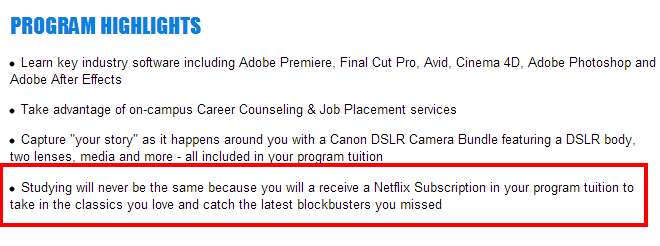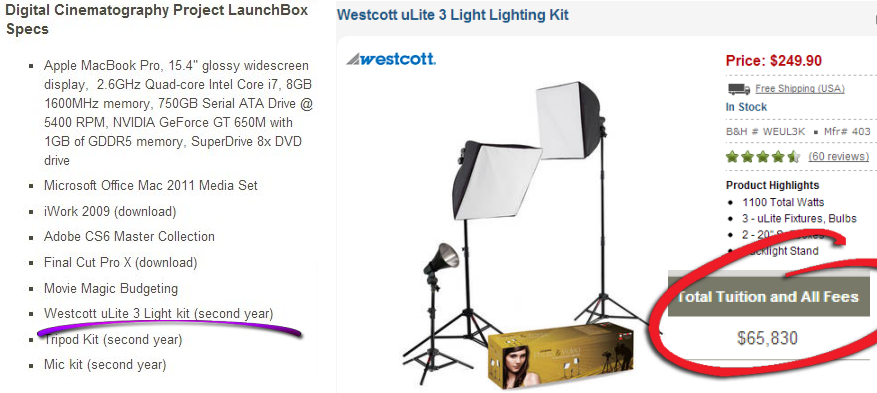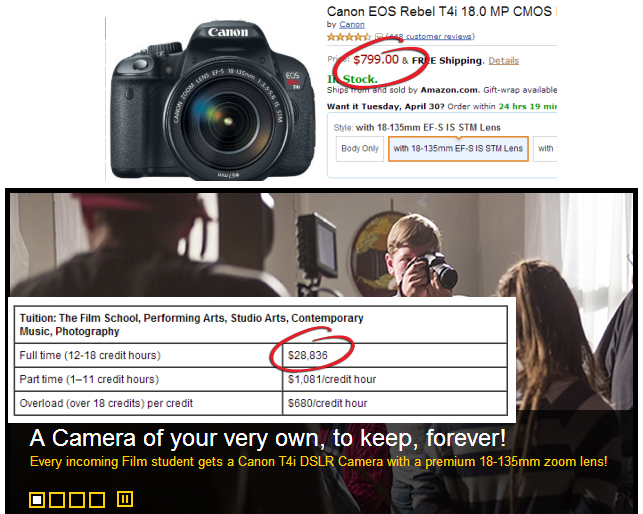Even though the cost of production equipment has plummeted over 100% in the past 10 years, the number of film schools in the same period of time has nearly tripled.
With Federal Student Aid still readily available, it’s become quite lucrative for schools to open their doors, cram 30 kids into a classroom at $30,000 a head, and teach them rudimentary filmmaking skills with used equipment.
However, the competition for students has become fierce, with new schools popping up every day. As such, the marketing department of both new and old schools is on overdrive to make their program seem the wisest investment for incoming students. But at the end of the day, all of these supposed bonuses are just gimmicks compared to what is really required to work in the film business.
The newest trend is to include very low cost digital filmmaking equipment as part of a student’s tuition. This is theoretically a great idea. After all, it’s 2013. Students at NYU are still paying $46,000 a year to use Panasonic DVX 100 cameras that cost $85 a day to rent. Students at the Art Institutes pay $90,000 for a 3 year program where they borrow consumer level DSLR cameras that can be purchased for $1,000 to $1,500.
So it’s somewhat refreshing to see a couple of schools stepping up and offering students the chance to OWN their a camera of their own rather than sharing equipment with 100 other students. The digital era as made this equipment affordable, so let’s take advantage.
It sounds like a good idea… but what about the execution?
1. $28,638 for an $800 Camera?
Santa Fe University, a relatively new school, offers students in their film program their own Canon t4i digital camera. This is a great camera; if lit properly its images rival much more expensive cameras on the market. However, the camera costs $700 to buy on Amazon and you still get to “keep it forever”, as the schools ad copy suggests. The film program at Santa Fe University is $28,836 without factoring in production costs.
Does that make sense? Just buy the darn camera on your own.
2. Video Symphony: $20,000 for Netflix?
Video Symphony’s year long New Media program has a $21,000 price tag. They also provide an entry level DSLR Video camera to students with 2 additional lenses, for an acknowledged $1,000 value. But the funniest thing is part of their marketing material, in which they highlight one of the many advantages of attending their program:

That one is my favorite. Yes, I don’t know how I would ever manage to get, much less afford, my own Netflix subscription without enrolling in an advanced film program.
Actually this highlights the main reason why film school certification is silly. In the old days you really needed a school to watch reel to reel movies. Today, not so much.
3. Full Sail: $65,000 for a $249 Lighting Kit
Full Sail is my favorite. Their Online Digital Cinematography Degree (dear God, please do not waste your life and money on this) costs a mere $70,000 for 2 years. I don’t know what the heck you do in the first year, because its only in the second year that you get your hands on some entry level production equipment.
And I do mean entry level. A laptop, some basic software. But my favorite is the lighting kit that costs $249 to buy at B&H:

If you want to invest your life savings to get basic filmmaking instruction and equipment you could have bought for a fraction of the cost, then by all means apply to one of these film schools. But if you’re serious about starting a directing career the smart way, then go to filmschoolsolution.com.
 Film School Secrets: Insider Advice for Aspiring Filmmakers Learn Filmmaking as Creative Professional, Not a Starving Artist
Film School Secrets: Insider Advice for Aspiring Filmmakers Learn Filmmaking as Creative Professional, Not a Starving Artist 
On the Number 3 slot there with Full Sail, the lighting kit is not the reason most of us decide to go to full sail.
If you go to the website, you’ll see that many famous people in the film business has graduated from full sail. This is not bogus information, Darren Bousman who was director of the SAW films I met personally. I’ve also worked on the WWE NXT shows and served with ESPN.
Most of the money spent at Full Sail goes towards the use of the backlot, the dubbing stage, the equipment, teaching you the best ways to use the equipment from INDUSTRY PROFESSIONALS. There is a lot more to Full Sail than the lighting kit.
Hi Brad,
Thanks for the comment. But so what? My point is that the majority of people working in the industry are doing so without school. So, I’d be curious to know if your colleagues at ESPN or WWE NXT went to film school, or not? The problem is the false appearance that a school like Full Sail is the only way, or even a faster way, into the business below the line.
A good example is Buz Wallick; I share his story here http://filmschoolsecrets.com/interview-working-as-a-dp-at-age-16. Buz shot the documentary “Never Sleep Again” about “Nightmare on Elm Street”. Buz’s story is compelling because he started at age 16. But his story is only one of thousands of people working in the biz who never shelled out for an expensive film school.
The example in this article is specifically for the Online Degree Program, for which students do not participate or utilize the equipment you mentioned.
But here’s the rub. What’s the point of paying to use all that expensive equipment when you graduate with a little short film real and no training on how to produce a feature and promote it? Mr. Bousman, like so many film school grad examples, is the exception to the rule. Full Sail graduates thousands of people every year, why is there only one or two names you can speak to as a successful director?
Best,
Seth
Haha, this made me laugh. I’m a filmmaker myself trying to build a reel and get my films shown at festivals and the fact that the schools promise such a basic equipment is hilarious. I can understand if they were willing to give out Arri Alexas to students who pay ridiculous fees, that’d be a huge wow factor, but a DSLR? Come on.
I live in the UK and got a DSLR with 2 lenses, a Rode Stereo mic with deadkitten, a DSLR Eimo rig and a continuous lighting kit for about £1000 ($1600). I’m working on my own films now after abandoning University – the film course there felt like a sluggish and wasteful opportunity, not trusting us to use the equipment and talking down to us about film as there’s only way to do it. Film is a diverse art with many opinions, styles and ideas in different people – you can’t teach it. You can only guide the people who have natural passions, but they have to formulate their own pathway too, not just rely on tired lecturers.
Hi Andrew,
Thanks for the comment. Good for you – that is very smart of you to recognize that and get your own equipment.
I do agree that conventional film programs absolutely suck (which is why I created this site). But I disagree that film cannot be taught, it just hasn’t been taught well in the last 30 years. That is why we created Film School Solution. You should check out the Webinar on the front page of the site and learn about the course. The webinar explains it in great detail (unlike film school where the tour consists of a walk around campus and no explanation of the actual curriculum). You will find it to be the most riveting, dynamic, useful film training – we don’t bullshit you with silly exercises. It’s all training in what matters: audience engagement, character likeability, tension, dialog, cinematic lighting, feature structure, and marketing.
Those are the essentials of making movies people actually want to watch. You can definitely just start shooting your own things, but the DSLR revolution has illustrated that just because high quality images are now within reach of the average person, it doesn’t mean people know how to tell a compelling story.
Seth